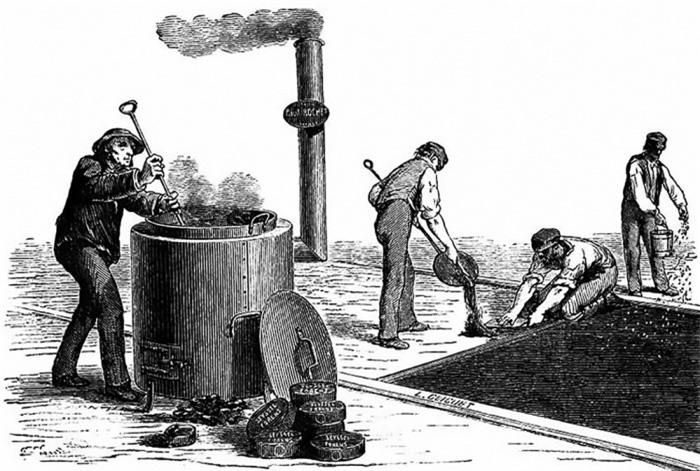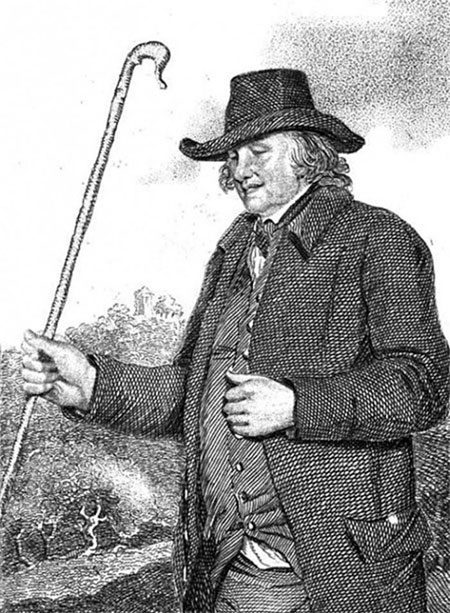The first roads were formed simply by people walking repeatedly to fetch water and search for food.
Later, as communities formed, humans were compelled to devise ways to move more quickly and conveniently, leading to advancements in road construction techniques.
The First Road Specialist Was… Visually Impaired

A depiction of asphalt paving from the 20th century.
The first stones used for road construction were discovered at ancient sites dating back around 4,000 years in the Indian subcontinent and Mesopotamia.
During ancient Roman times, to facilitate the movement of soldiers throughout the formation and existence of the empire, they invented several high-durability road construction techniques, such as using multiple layers of materials, with the bottom layer consisting of crushed stone for drainage purposes.
Some roads are still in use more than 2,000 years later, and these techniques form the foundation for modern road construction today.
When discussing the early engineers who laid the groundwork for modern road construction techniques, one must mention the outstanding engineers from Scotland. The first among them is John Metcalfe, known as the “father of modern roads,” despite his visual impairment.
He made his mark in history with the first major road construction project in England in 1717, during the Industrial Revolution. John Metcalf (also known as Blind Jack of Knaresborough or Blind Jack Metcalf) became blind at the age of six due to complications from smallpox.
Despite a tumultuous life, he continuously sought self-improvement, gaining knowledge in various fields and experiencing many professions, from musician and trader to carrier, before joining the military.
John Metcalf is best known for his work between 1765 and 1792, during which he pioneered the construction of a total of 290 kilometers of major roads, primarily in northern England.
His road-building career began after the British Parliament passed a bill allowing the construction of major roads in the Knaresborough area. As one of the very few people with road construction experience at the time, Metcalf quickly seized the opportunity and built based on the practical knowledge he gained while working in freight transport.
John Metcalf secured a contract to construct a 5-kilometer road connecting the villages of Minskip and Ferrensby along the route from Harrogate to Boroughbridge. He personally researched the assigned task and transformed it into the most useful road possible.
With years of experience in horse-drawn freight transport, John Metcalf believed that a good road must have a solid foundation, effective drainage, and a smooth surface to allow rainwater to drain quickly into roadside ditches.
He understood the importance of drainage, as rainwater causes many issues that hinder travel. He discovered how to use willow and flowering rush, bundling them together to create a foundational layer for the road.
The First Paved Roads

Portrait of John Metcalf – the first professional road builder in the world.
The first use of asphalt in road construction dates back to 1824 when the first blocks of asphalt were laid on the Champs-Élysées in Paris.
However, modern asphalt is the result of research by a Belgian immigrant named Edward de Smedt at Columbia University in the United States, developed in 1872.
The first roads using modern asphalt techniques were in Battery Park and on Fifth Avenue in New York in 1872, and on Pennsylvania Avenue in Washington, D.C., in 1877.
Based on these foundations, combined with the historical context of numerous hot and cold wars in the 20th century, which heightened the demand for road construction to facilitate military movement at the fastest possible pace, highways emerged with famous names that persist to this day, such as Germany’s Autobahn and the U.S. Interstate System.
One of the significant contributors to road construction techniques worldwide is John McAdam (Scotland). He devised a method of covering the road with a layer of earth and crushed stone, then rolling over it with heavy vehicles to compact the material in the early 19th century.
This design led to a significant advancement in modern road construction techniques, known as “macadam road.” Road construction techniques that best facilitate vehicle movement began to appear in the 20th century, built upon McAdam’s methods but incorporating asphalt as a binding agent.





















































